Free Restaurant Contingency Plan

I. Introduction
A. Purpose of the Contingency Plan
The purpose of this Contingency Plan is to provide a structured framework for [Your Company Name] to prepare for, respond to, and recover from unexpected disruptions that could affect restaurant operations. This plan aims to ensure the safety of employees and customers, minimize financial losses, and maintain operational continuity during and after emergencies.
B. Scope and Applicability
This Contingency Plan applies to all locations and departments within [Your Company Name]. It covers a wide range of potential emergencies, including natural disasters, man-made disasters, health emergencies, operational disruptions, and security threats. The plan is designed to be adaptable to various scenarios to provide effective and efficient responses.
C. Objectives
The primary objectives of this Contingency Plan are:
To ensure the safety and well-being of all employees and customers.
To maintain critical operations and minimize disruptions.
To protect the company's assets and resources.
To provide clear communication and instructions during emergencies.
To facilitate a swift and effective recovery process.
D. Key Definitions and Terms
Contingency Plan: A strategy outlining procedures to follow in the event of an emergency or disruption.
Risk Assessment: The process of identifying and analyzing potential risks.
Business Continuity: The ability to maintain essential functions during and after a disaster.
Recovery Plan: A strategy for restoring normal operations after an emergency.
II. Risk Assessment and Management
A. Identification of Potential Risks
1. Natural Disasters
Natural disasters such as earthquakes, floods, and hurricanes can have a devastating impact on restaurant operations. For example:
Earthquakes: May cause structural damage to the building, posing risks to staff and customers.
Floods: Can lead to water damage, contamination of food supplies, and electrical hazards.
Hurricanes: Potentially cause power outages, supply chain disruptions, and physical damage to the property.
2. Man-Made Disasters
Man-made disasters, including fires and power outages, require proactive measures to mitigate their effects:
Fires: These can result in severe damage to property, loss of inventory, and injuries.
Power Outages: Affect refrigeration, cooking equipment, and lighting, leading to food spoilage and safety concerns.
3. Health Emergencies
Health emergencies, such as pandemics and foodborne illnesses, can significantly impact restaurant operations:
Pandemics: Require stringent hygiene practices, social distancing, and potentially reduced operating hours.
Foodborne Illnesses: Result in health risks to customers and can damage the restaurant's reputation.
4. Operational Risks
Operational risks include equipment failures and supply chain disruptions:
Equipment Failure: Breakdowns in kitchen appliances can halt food preparation and service.
Supply Chain Disruptions: This can lead to shortages of essential ingredients and supplies.
5. Security Risks
Security risks such as theft and vandalism must be addressed to protect the restaurant's assets:
Theft: This can result in financial losses and impact employee morale.
Vandalism: Causes property damage and may require costly repairs.
B. Risk Analysis
1. Likelihood of Occurrence
To effectively manage risks, it's essential to assess the likelihood of each risk occurring. Table 1 provides an overview of potential risks and their likelihood based on historical data and local conditions.
Risk Type | Likelihood (1-5) |
|---|---|
Earthquakes | 3 |
Floods | 2 |
Hurricanes | 4 |
Fires | 3 |
Power Outages | 5 |
Pandemics | 4 |
Foodborne Illnesses | 3 |
Equipment Failure | 4 |
Supply Chain Issues | 3 |
Theft | 2 |
Vandalism | 2 |
2. Potential Impact on Operations
The impact of each risk on restaurant operations is assessed based on severity, with Table 2 summarizing the potential impacts.
Risk Type | Impact (1-5) |
|---|---|
Earthquakes | 5 |
Floods | 4 |
Hurricanes | 5 |
Fires | 5 |
Power Outages | 4 |
Pandemics | 5 |
Foodborne Illnesses | 5 |
Equipment Failure | 4 |
Supply Chain Issues | 3 |
Theft | 3 |
Vandalism | 2 |
C. Risk Mitigation Strategies
1. Preventive Measures
Implementing preventive measures can reduce the likelihood and impact of potential risks:
Earthquake-Resistant Structures: Reinforce building structures to withstand earthquakes.
Flood Barriers: Install barriers and drainage systems to protect against flooding.
Fire Safety Systems: Equip the restaurant with fire alarms, extinguishers, and sprinklers.
Backup Generators: Ensure the availability of backup power sources to handle outages.
Health Protocols: Implement strict hygiene practices to prevent pandemics and foodborne illnesses.
Regular Maintenance: Schedule routine maintenance for all equipment to prevent failures.
Security Systems: Install surveillance cameras and alarm systems to deter theft and vandalism.
2. Insurance Coverage
Obtaining comprehensive insurance coverage is crucial for mitigating financial risks. [Your Company Name] should consider policies that cover:
Property damage from natural and man-made disasters.
Business interruption to compensate for lost income during recovery.
Liability insurance to cover health emergencies and customer claims.
3. Safety Protocols
Develop and enforce safety protocols to protect employees and customers:
Emergency Drills: Conduct regular drills to ensure staff are familiar with evacuation routes and procedures.
Health Screenings: Implement regular health checks for staff to prevent the spread of illnesses.
Food Safety Training: Provide comprehensive training on food handling and hygiene.
III. Emergency Response Plan
A. Emergency Contact Information
Maintaining an updated list of emergency contacts is vital for effective communication during crises.
1. Internal Contacts
Management Team: Ensure all members of the management team have updated contact information.
Staff Contacts: Keep an updated list of all employees with their contact details.
2. External Contacts
Emergency Services: Maintain contact information for local police, fire departments, and medical services.
Suppliers: Have contact information for key suppliers to manage disruptions in the supply chain.
Utilities: Ensure contact details for utility providers (electricity, water, gas) are readily available.
B. Evacuation Procedures
Clear and well-communicated evacuation procedures are essential for ensuring the safety of everyone in the restaurant during an emergency.
1. Evacuation Routes
Designate and clearly mark evacuation routes throughout the restaurant. Ensure all staff are familiar with these routes and conduct regular drills to practice evacuations.
2. Assembly Points
Identify safe assembly points where staff and customers can gather after evacuating the building. Ensure these points are away from potential hazards and accessible to emergency services.
3. Accountability Procedures
Implement procedures to account for all staff and customers during an evacuation. Assign specific roles to staff members to ensure everyone is accounted for and safe.
C. Communication Plan
Effective communication is crucial during emergencies to keep everyone informed and coordinated.
1. Notification Methods
Utilize multiple communication methods to ensure messages reach all relevant parties:
Text Messages: Use group messaging services to quickly notify staff of emergencies.
Email Alerts: Send detailed email updates to staff and stakeholders.
Public Address System: Use the restaurant's PA system to announce emergency instructions.
2. Media Handling
Designate a spokesperson to handle media inquiries during emergencies. Provide clear and consistent messages to the media to ensure accurate information is communicated to the public.
3. Customer Communication
Keep customers informed of emergency situations and any impact on operations. Use social media, the restaurant's website, and email newsletters to communicate updates.
D. Emergency Supplies and Equipment
Ensure the restaurant is equipped with necessary emergency supplies and equipment to handle various situations.
1. First Aid Kits
Maintain well-stocked first aid kits in accessible locations throughout the restaurant. Train staff on basic first aid procedures.
2. Fire Extinguishers
Place fire extinguishers in key locations and ensure staff are trained on their use. Conduct regular inspections to ensure they are in working order.
3. Backup Power Sources
Install backup power sources, such as generators, to maintain critical operations during power outages. Ensure these are regularly tested and maintained.
IV. Business Continuity Plan
A. Continuity of Operations
Identifying and prioritizing critical functions is essential for maintaining business continuity during disruptions.
1. Identifying Critical Functions
Determine which operations are essential to continue running during an emergency. These may include:
Food preparation and service
Customer communication
Financial transactions
Supply chain management
2. Prioritizing Essential Services
Develop a plan to prioritize and maintain these critical functions. This may involve reallocating resources, adjusting staffing levels, and modifying operating hours.
B. Resource Management
Effective resource management ensures that essential services can continue during emergencies.
1. Staff Allocation
Determine staffing needs for critical functions and develop a plan to reassign staff as needed. Cross-train employees to perform multiple roles to increase flexibility.
2. Inventory Management
Maintain an adequate inventory of essential supplies and ingredients. Develop relationships with multiple suppliers to ensure a reliable supply chain.
3. Financial Resources
Establish a financial contingency plan to manage cash flow during disruptions. This may include setting aside emergency funds and identifying potential sources of financial assistance.
C. Alternative Arrangements
Prepare for scenarios where normal operations may not be possible.
1. Temporary Locations
Identify alternative locations where the restaurant can operate if the primary location is unavailable. This may include partnering with other local businesses or setting up mobile operations.
2. Mobile Operations
Develop plans for mobile operations, such as food trucks or delivery services, to continue serving customers during disruptions.
3. Remote Work Options
For administrative and management functions, develop remote work options to ensure continuity of operations.
D. Technology and Data Management
Protecting and managing technology and data is crucial for maintaining business continuity.
1. Data Backup Procedures
Implement regular data backup procedures to ensure critical information is protected. Store backups in secure, off-site locations.
2. IT Support
Ensure access to reliable IT support to address technical issues quickly. Develop relationships with IT service providers for emergency support.
3. Cybersecurity Measures
Implement robust cybersecurity measures to protect against data breaches and cyberattacks. Train staff on cybersecurity best practices.
V. Training and Awareness
A. Staff Training Programs
Regular training programs ensure staff are prepared to respond effectively to emergencies.
1. Emergency Response Training
Provide comprehensive training on emergency response procedures, including evacuation routes, fire safety, and first aid.
2. Safety Drills and Simulations
Conduct regular safety drills and simulations to practice emergency procedures. Use these exercises to identify areas for improvement.
3. Role-Specific Training
Provide role-specific training to ensure staff understand their responsibilities during emergencies. This includes training for management, kitchen staff, and front-of-house employees.
B. Regular Updates and Reviews
Regularly updating and reviewing the contingency plan ensures it remains effective and relevant.
1. Plan Review Schedule
Establish a schedule for reviewing and updating the contingency plan. This should occur at least annually and after any major incidents.
2. Updating Procedures
Develop procedures for making updates to the contingency plan. This includes incorporating lessons learned from drills and actual emergencies.
C. Documentation and Record Keeping
Maintaining thorough documentation and records is essential for effective contingency planning.
1. Training Records
Keep detailed records of all training sessions, including attendance, topics covered, and outcomes.
2. Incident Reports
Document all incidents, including responses and outcomes, to identify trends and areas for improvement.
3. Compliance Records
Maintain records to demonstrate compliance with relevant regulations and standards.
VI. Recovery and Restoration
A. Damage Assessment
1. Initial Assessment Procedures
Immediately following an emergency, [Your Company Name] will conduct an initial damage assessment to determine the extent of the impact. This involves:
Safety Inspection: Ensuring the area is safe for entry and that no immediate hazards (e.g., structural damage, or gas leaks) are present.
Preliminary Evaluation: Assessing the overall condition of the restaurant, including structural integrity, utilities, and critical systems.
Photographic Documentation: Taking photos and videos of the damage for insurance and recovery planning purposes.
2. Detailed Damage Report
After the initial assessment, a comprehensive damage report will be prepared. This report will include:
Structural Damage: Detailed descriptions of any damage to the building, including walls, ceilings, floors, and foundations.
Utilities and Infrastructure: Assessment of damage to electrical, plumbing, and HVAC systems.
Equipment and Inventory: Inventory of damaged equipment and supplies, including kitchen appliances, furniture, and food stock.
Financial Impact: Estimation of the financial cost of the damage, including repair, replacement, and lost revenue.
B. Recovery Plan
1. Short-Term Recovery Actions
The short-term recovery plan focuses on stabilizing operations and beginning the process of rebuilding. Key actions include:
Temporary Repairs: Conducting immediate repairs to prevent further damage and ensure safety (e.g., boarding up windows, covering roof damage).
Utilities Restoration: Working with utility providers to restore essential services such as electricity, water, and gas.
Cleaning and Sanitization: Thoroughly cleaning and sanitizing the restaurant to ensure it is safe for staff and customers.
2. Long-Term Restoration Plan
The long-term restoration plan outlines steps to fully restore the restaurant to normal operations. This includes:
Comprehensive Repairs: Undertaking all necessary structural repairs, including rebuilding damaged areas.
Equipment Replacement: Purchasing and installing new equipment to replace items that were damaged beyond repair.
Financial Planning: Managing the financial aspects of recovery, including insurance claims, loans, and grants.
Reopening Strategy: Develop a strategy for reopening the restaurant, including marketing and customer communication.
C. Financial Recovery
1. Insurance Claims
Efficiently managing insurance claims is crucial for financial recovery. The process involves:
Documenting Losses: Providing detailed documentation of all damages and losses to the insurance company.
Claim Submission: Submitting the insurance claim promptly and following up regularly to expedite processing.
Claim Settlement: Working with the insurance adjuster to ensure fair settlement of the claim.
2. Financial Assistance Programs
In addition to insurance, [Your Company Name] may seek financial assistance through various programs, such as:
Government Grants: Applying for federal, state, and local grants designed to assist businesses in recovery.
Loans: Exploring low-interest loan options from banks and the Small Business Administration (SBA).
Community Support: Engaging with community fundraising efforts and seeking support from local organizations.
D. Post-Incident Analysis
1. Incident Review
After the recovery process is underway, conducting a thorough review of the incident is essential. This involves:
Incident Debrief: Holding meetings with staff to discuss what happened, how it was handled, and what could be improved.
Data Collection: Gathering all relevant data, including timelines, decisions made, and resources used.
Analysis: Analyzing the data to identify strengths and weaknesses in the response.
2. Lessons Learned
Identifying and documenting lessons learned from the incident helps improve future contingency planning. Key points include:
Successful Strategies: Highlighting what worked well and should be continued in future responses.
Areas for Improvement: Identifying specific areas where the response could be improved and developing action plans to address these issues.
3. Plan Improvements
Based on the lessons learned, [Your Company Name] will update and enhance its Contingency Plan. This involves:
Policy Revisions: Updating policies and procedures to reflect new insights and best practices.
Training Adjustments: Modifying training programs to incorporate lessons learned and improve staff readiness.
Resource Allocation: Adjusting resource allocations to better prepare for future incidents.
- 100% Customizable, free editor
- Access 1 Million+ Templates, photo’s & graphics
- Download or share as a template
- Click and replace photos, graphics, text, backgrounds
- Resize, crop, AI write & more
- Access advanced editor
Prepare for emergencies with Template.net's Restaurant Contingency Plan Template. This customizable and editable template, accessible through the Ai Editor Tool, helps you develop a response strategy. Personalize it to cover potential risks and scenarios. Create a comprehensive contingency plan to ensure your restaurant can respond effectively to unexpected events and maintain business continuity.
You may also like
- Finance Plan
- Construction Plan
- Sales Plan
- Development Plan
- Career Plan
- Budget Plan
- HR Plan
- Education Plan
- Transition Plan
- Work Plan
- Training Plan
- Communication Plan
- Operation Plan
- Health And Safety Plan
- Strategy Plan
- Professional Development Plan
- Advertising Plan
- Risk Management Plan
- Restaurant Plan
- School Plan
- Nursing Home Patient Care Plan
- Nursing Care Plan
- Plan Event
- Startup Plan
- Social Media Plan
- Staffing Plan
- Annual Plan
- Content Plan
- Payment Plan
- Implementation Plan
- Hotel Plan
- Workout Plan
- Accounting Plan
- Campaign Plan
- Essay Plan
- 30 60 90 Day Plan
- Research Plan
- Recruitment Plan
- 90 Day Plan
- Quarterly Plan
- Emergency Plan
- 5 Year Plan
- Gym Plan
- Personal Plan
- IT and Software Plan
- Treatment Plan
- Real Estate Plan
- Law Firm Plan
- Healthcare Plan
- Improvement Plan
- Media Plan
- 5 Year Business Plan
- Learning Plan
- Marketing Campaign Plan
- Travel Agency Plan
- Cleaning Services Plan
- Interior Design Plan
- Performance Plan
- PR Plan
- Birth Plan
- Life Plan
- SEO Plan
- Disaster Recovery Plan
- Continuity Plan
- Launch Plan
- Legal Plan
- Behavior Plan
- Performance Improvement Plan
- Salon Plan
- Security Plan
- Security Management Plan
- Employee Development Plan
- Quality Plan
- Service Improvement Plan
- Growth Plan
- Incident Response Plan
- Basketball Plan
- Emergency Action Plan
- Product Launch Plan
- Spa Plan
- Employee Training Plan
- Data Analysis Plan
- Employee Action Plan
- Territory Plan
- Audit Plan
- Classroom Plan
- Activity Plan
- Parenting Plan
- Care Plan
- Project Execution Plan
- Exercise Plan
- Internship Plan
- Software Development Plan
- Continuous Improvement Plan
- Leave Plan
- 90 Day Sales Plan
- Advertising Agency Plan
- Employee Transition Plan
- Smart Action Plan
- Workplace Safety Plan
- Behavior Change Plan
- Contingency Plan
- Continuity of Operations Plan
- Health Plan
- Quality Control Plan
- Self Plan
- Sports Development Plan
- Change Management Plan
- Ecommerce Plan
- Personal Financial Plan
- Process Improvement Plan
- 30-60-90 Day Sales Plan
- Crisis Management Plan
- Engagement Plan
- Execution Plan
- Pandemic Plan
- Quality Assurance Plan
- Service Continuity Plan
- Agile Project Plan
- Fundraising Plan
- Job Transition Plan
- Asset Maintenance Plan
- Maintenance Plan
- Software Test Plan
- Staff Training and Development Plan
- 3 Year Plan
- Brand Activation Plan
- Release Plan
- Resource Plan
- Risk Mitigation Plan
- Teacher Plan
- 30 60 90 Day Plan for New Manager
- Food Safety Plan
- Food Truck Plan
- Hiring Plan
- Quality Management Plan
- Wellness Plan
- Behavior Intervention Plan
- Bonus Plan
- Investment Plan
- Maternity Leave Plan
- Pandemic Response Plan
- Succession Planning
- Coaching Plan
- Configuration Management Plan
- Remote Work Plan
- Self Care Plan
- Teaching Plan
- 100-Day Plan
- HACCP Plan
- Student Plan
- Sustainability Plan
- 30 60 90 Day Plan for Interview
- Access Plan
- Site Specific Safety Plan





























